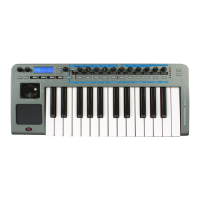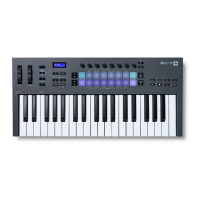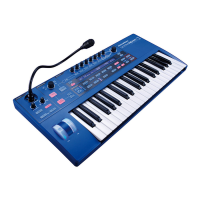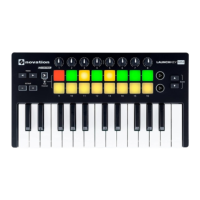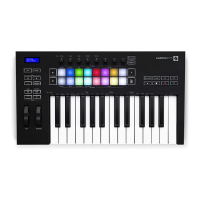The Effects Section
In KS Synth mode, all settings associated with the
Effects are to be found within the Dual Multi Effects
Processor section of the front panel.
The section of the X-Station front panel labeled
Effects is used only to control the Synth’s Part
Volume level.
LEVEL Knob
Sets the post-Effects signal level (Part Volume). The setting can also be
controlled by MIDI CC7 (Volume).
SELECT Button & CONTROL Knob
These controls do not affect any of the KS Synth’s sound parameters.
However, they can be defined to transmit user defined MIDI information
in a similar manner to the way controls are used in a standard X-Station
Template. This is described in the section detailing KS Synth General
Settings on page 53.
The Oscillator Menu
To complement the front panel controls in the Oscillator section, there
are many other functions located in the Oscillators Menu.
This is selected by pressing the MONO / POLY but-
ton in the Amp Env section on the front panel. Use
the BANK / PAGE up/down buttons to scroll through
the Menu functions available - See the table below.
Polyphony Mode (Menu Page 1 ‘OSC Poly Mode’)
This setting determines if the Synth patch plays in a polyphonic or
monophonic manner.
When set to MONO or MONO AG, the
Program plays monophonically (ie only
one note can be sounded at any one
time). If a chord is played on the key-
board, it will be noticed that as each
individual note is released, the note
sounding will revert back to the nearest
played note.
The MONO AG setting enables ‘Auto glide’ (portamento) to be triggered
whenever a note is played on the keyboard before the previously held
down note has been released (legato playing). Using ‘Auto glide’ in this
way can greatly add expressiveness to a Program. It is especially effec-
tive when applied to lead type sounds.
The monophonic settings are often useful when replicating sounds in
the ‘real world’ which would normally be played monophonically, for
example a bass guitar.
As their name implies, the POLY 1 and POLY 2 settings allow poly-
phonic operation.
POLY1 allows successive playing of the same note(s) to be ‘stacked’
together, gradually producing a louder sound texture as the note(s) are
repeatedly played.
With POLY2, if the same note(s) are played repeatedly, they will use
the same synthesizer voices as used previously, thus avoiding the
‘stacked note’ effect.
Unison Detune (Menu Page 2 ‘OSC Uni Detune’)
Unison Detune is used in conjunction with the UNISON button as
described on page 37. When using more than one voice per note, the
Unison detune amount sets how much each voice is detuned relative to
the others. Adjust the amount until the desired effect is heard.
VCO Drift (Menu Page 3 ‘OSC Vco Drift’)
Controls the amount of tuning drift for the Oscillators. Setting a modest
value, 10 for example will cause each Oscillator to slowly drift fraction-
ally out of tune. Classic Analogue Synthesizers were known to gradual-
ly go out of tune as the internal circuits heated up. This ‘instability’ actu-
ally helped to give them their own unique character!
THE KS SYNTHESIZER
The Effects Section - The Oscillator Menu
• 44 •
Page Function Top Line Display Value
1 Polyphony Mode OSC Poly Mode MONO…POLY 2
2 Unison Detune OSC Uni Detune 0…127
3 VCO Drift OSC Vco Drift 0…127
4 Preglide Semitones OSC Preglide -12…12
5 Portamento Mode OSC Porta Mode EXP-LIN
6 Start Phase OSC Start Phase OFF 1..127
7 Osc 2 - 3 FM Manual Level OSC 23 FM Level 0…127
8 Osc 2 - 3 FM Env Amt OSC 2>3 FM ADEnv -64…63
9 Osc 2 - 3 FM LFO1 OSC 2>3 FM Lfo1 -64…63
10 Osc Fixed Note Replay OSC Fixed Note OFF, C#-2…G8

